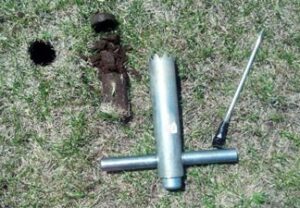
An important first step in completing an athletic campus needs assessment and master plan is the sampling and agronomic testing of fields’ root zone materials to evaluate soil structure, organic content, micronutrient levels and pH. Testing is a key factor in developing the proper maintenance or rehabilitation strategy for improved turf growth.
Over the years, Gale has observed a significant trend in our testing results. Athletic fields, particularly in northern New England, tend to be more acidic. These fields must be maintained to hold up under substantial use, requiring considerable planning and maintenance to sustain their soil quality. Over the past two years, we have documented and recovered soil samples with an average pH of 5.2, and with individual values below 5.0. This significant level of acidity results from the gradual breakdown of indigenous plant materials in the soil, and is exacerbated by the influence of acid rain.
Why should we be concerned with this?
According to the Massachusetts Natural Resources Collaborations (Mass NRC), the pH of the soil directly affects the amount of nutrients available to grass cultivars. Cultivars are varieties of plants produced in cultivation by selective breeding. They can ingest the wrong nutrients when pH levels are not optimal. Preferred nutrients are most accessible when the pH is in the range of 6.0 to 7.0. With average pH ranges consistently below 5.5, regardless of the fertilizer regimen, turf grass is often starved. For example, Kentucky Blue Grass blends, often selected for athletic turf grass based on their restorative capacity due to their rhizome generation, cannot prorogate as intended and fields break down under normal use.
How can we fix the issue?
Lime! The UMASS Department of Agronomy provides specific lime application strategies for each soil sample tested. While there are multiple considerations for crafting a pH adjustment strategy, low pH root zones with values less than 5.4 generally call for lime application rates of up to 150 pounds of limestone per 1,000 SF, applied at a rate of no more than 50 pounds per spring or fall season. For a typical 90,000 SF multi-purpose rectangular field, this amounts to 4,500 pounds per season for three consecutive seasons. In summary, test the soil and be prepared to apply lime for a happier, healthier natural turf field.
Tagged In:
Athletic Facilities Planning & Design
